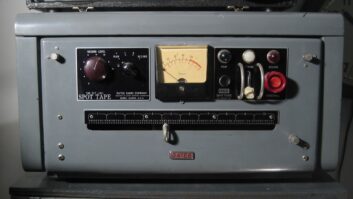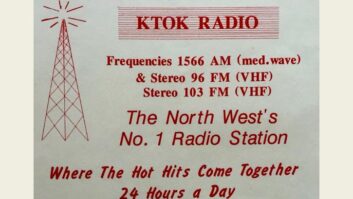It’s hard to visualize, but we broadcasters are the future providers of radio datacasting services. We can’t wait for someone else to develop our airwaves – to become “service providers.”
I couldn’t resist responding to the gauntlet thrown down by my esteemed colleague Skip Pizzi (“The IBOC Debate Continues,” April 24). Skip seems to be waiting to see if “service providers will emerge in force to take advantage of” datacasting on IBOC.
This is the wrong way to look at our future as broadcasters. The folks at Impulse Radio have the right idea – make the datacasting capabilities of IBOC something broadcasters can work with and mold to consumer benefit.
If we wait for service providers to emerge, we simply push IBOC data into the subcarrier abyss. Niche providers with proprietary technologies pay a pittance for poorly utilized subcarrier bandwidth. Let’s not let that happen with IBOC data capacity.
Open platform
The way to make IBOC a robust consumer medium, beyond the improved audio performance, is to create a universal open platform for moving digital content to consumer receivers. Make it so that broadcasters can use their current business skills and programming skills to enhance the listener experience, and, yes, generate new revenue streams.
Skip admonishes you to “remember also that the PAD (program associated data) feature was touted as something RBDS would provide, but never did.” I’m sorry Skip missed our presentation at the NAB2002 Broadcast Engineering Conference. We traced the shortcomings of RBDS and other subcarriers to several factors.
The biggest problem is that RBDS was not designed with new revenue in mind. Without revenue for the data, radio stations can only rationalize feeding the simplest of data from their automation systems. And without the creative drive of broadcasters behind the RBDS technology, there was no sizzle for consumers in the United States. Because RBDS was not designed as a flexible, extensible, object-oriented data transmission scheme, it failed to spark an evolution of new, consumer-oriented services.
Impulse Radio, in collaboration with Ibiquity and the IBOC Data Forum, has been developing an open protocol for data over IBOC. (Impulse and Ibiquity are independent companies with no connection but a shared vision of the power of IBOC.)
The fast-track development of IBOC has led to a fast track for the data services as well. To facilitate the efforts to quickly build the foundation for data over IBOC, Ibiquity wisely convened a specification forum (sometimes called a standards forum, but standardization will come more formally in time).
Broadcasters, content providers and electronics manufacturers were invited to participate in the process of building the foundation for IBOC data. Impulse spearheaded the gathering of “Use Cases” and the creation of a first-round proposed specification.
Over recent months, the forum has had two national meetings, one in Detroit and one in Las Vegas. Numerous communications and smaller meetings have occurred to merge hundreds of ideas into a proposed specification.
This is only the beginning of the open process envisioned for IBOC data. When the market is ready and the industry is prepared to support the process (and this includes your employer, dear reader) the data specification can be ushered through a full standardization process.
Possibilities
Skip complains that “the bottom line is not how ‘open’ the development process seems, but who ultimately controls the implementation of the spec when it’s deployed.”
Well, there is plenty of room on the bandwagon to contribute to the data specification and create a home for its continuing development. By the way, RBDS was imported from Europe through an open standardization process. It was deployed, with the infusion of megabucks by the consumer electronics industry, without a mechanism for it becoming an evolving economically robust service. Standards, open or not, couldn’t help RBDS become the next big thing.
The bottom line, Skip, isn’t control; it is the bottom line. Whether you are commercial or noncommercial, you have to line up an audience to serve, and make money to pay for serving them.
Impulse Radio recognizes this and is the only company to propose a platform that amplifies broadcaster skills to provide new services and pay for them. What’s truly open about this data platform is that Ibiquity and Impulse and all the broadcasters and manufacturers who contributed to it leave it open to the creativity and salesmanship of broadcasters to use it to entertain and inform.
Meanwhile, consumer electronics manufacturers are eager to create new feature-rich radios that enable broadcasters to transmit data objects to the public. It could be program associated data (what we call program-synchronized data) or it could be data that relates to the audience, but is not directly tied to the flow of the program (station-related data).
Finally, there is room in the spec for data unrelated to the station’s audience, as subcarrier data often is today (auxiliary data).
Object-oriented data
Rome wasn’t built in a day, and feature-rich radio broadcasting won’t be either.
To begin with, rather than rigidly transmitting station call sign and artist and song title, RBDS-style, Impulse Radio proposes to use the more flexible object-oriented data features of IBOC to enable consumer radios to receive and render text objects of any type.
In the first baby step, early IBOC radios can exploit the text displays of satellite-ready radios. Broadcasters can easily start delivering useful text information, entertainment and sponsor elements when IBOC is launched.
As radios evolve and broadcasters generate new services and revenue with new data tools, feature-rich radio broadcasting will grow steadily.
So the questions are these: how should the IBOC data specifications be rolled into standards? Under whose umbrella should the standards setting be conducted? If data standards are truly a concern, are more broadcasters willing to sponsor their technical people in participating in standards setting than those who have already stepped up to the forum?
Finally, to eliminate possible confusion of the various elements of standardization, we should look at the development of IBOC. Ibiquity is the culmination of a decade-long competitive effort in IBOC development by many entities, including the two final proponents whose technologies were joined in the formation of Ibiquity. It created the physical layer of transmitting digits. It remains Ibiquity’s job to marry the digital waveform to such things as error correction technology, optimum interleave period and the audio codec technology. These elements and others have to be jointly optimized to the RF channel.
I don’t see any way, or reason, to call for this to be a democratic process. IBOC would not have gotten this far without the concerted efforts of highly focused expert enterprises.
Rising through the physical, transport and link layers, responsibility for developing specifications is able to diverge from strictly Ibiquity’s domain to all stakeholders in the success of IBOC. NPR proposes a secondary audio program “stream” that can run at low bit rates. Ibiquity accommodates this concept with a proposed “Secondary Program Service” (SPS) mode. Impulse Radio proposes a universal object-oriented data transmission capability, and Ibiquity responds with a proposed “eXtensible Data Service” (XDS) mode.
With those two enhancements proposed from outside Ibiquity and accommodated by them, the utility of IBOC is maximized. A secondary low-rate audio stream, if accepted by the industry and the FCC, would become available for universal and widespread applications. Meanwhile, the desire to move any kind of data object is accommodated by the provision of XDS.
Specifications ahead
What’s left? We need to agree on specifications for program-synchronized and station-related data. This will give broadcasters confidence in how their data will be experienced by the radio user and consumer electronics manufacturers will know what their displays, memory, I/O and other characteristics must do to support a certain level of functionality. So all have to agree on receiver classes and service classes upon which feature-rich radio will be built.
We also need to begin building protocols for authentication, rights management, security, encryption and other aspects of managing data flow over the broadcast channel. I see the IBOC Data Forum as the logical place to continue this discussion until some time when there is enough momentum to enter standards-setting.
With a forward-thinking data standard based on the groundwork of Impulse Radio and Ibiquity, data over radio will no longer be relegated to the backwater of private and tiny-niche services. Instead, for the first time, radio broadcasters will be able to build economically viable data services that reach consumer receivers without relying upon outsiders to create them.
More information can be found on data specifications and use cases at www.impulseradio.com, including our white paper on the use of a data gateway to manage data flow. Also look at www.ibiquity.com for more information on IBOC technology, and the NRSC pages at www.nab.org/scitech/nrsc where the studies and evaluations of AM and FM IBOC can be downloaded.
RW welcomes other points of view.
Skip Pizzi is contributing editor of Radio World.







